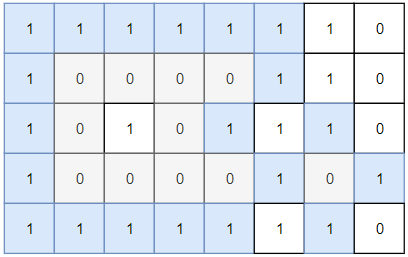Given a 2D grid consists of 0s (land) and 1s (water). An island is a maximal 4-directionally connected group of 0s and a closed island is an island totally (all left, top, right, bottom) surrounded by 1s.
Return the number of closed islands.
Example

Input: grid = [[1,1,1,1,1,1,1,0],[1,0,0,0,0,1,1,0],[1,0,1,0,1,1,1,0],[1,0,0,0,0,1,0,1],[1,1,1,1,1,1,1,0]]
Output: 2
Explanation:
Islands in gray are closed because they are completely surrounded by water (group of 1s).
Solution
/**
* @param {number[][]} grid
* @return {number}
*/
var closedIsland = function (grid) {
//Assign count, rows, and cols
let m = grid.length;
let n = grid[0].length;
let count = 0;
//Function to check if island is closed
function dfs(x, y, grid) {
if (
x < 0 ||
x >= grid.length ||
y < 0 ||
y >= grid[0].length ||
grid[x][y] == 1
) {
return;
}
//Mark as visited
grid[x][y] = 1;
dfs(x + 1, y, grid);
dfs(x - 1, y, grid);
dfs(x, y + 1, grid);
dfs(x, y - 1, grid);
}
// Exclude connected group of 0s on the corners because they are not closed island.
for (let i = 0; i < m; i++) {
for (let j = 0; j < n; j++) {
//If 0 and on the edge, run dfs
if (grid[i][j] == 0 && (i == 0 || i == m - 1 || j == 0 || j == n - 1)) {
dfs(i, j, grid);
}
}
}
// Count the number of connected component of 0s on the grid.
for (let i = 1; i < m - 1; i++) {
for (let j = 1; j < n - 1; j++) {
//If 0, increment count and run dfs
if (grid[i][j] == 0) {
dfs(i, j, grid);
count++;
}
}
}
return count;
};